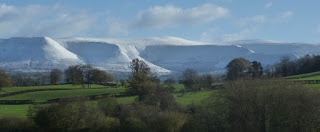I hope all of you out there had a great festive season, or if Christmas isn’t your thing then you have been enjoying yourself. I seem to have been everywhere except by the laptop, hence the long silence. One place I did visit just before Christmas was sunny Devon, but as I found it gloomy and misty I decided to make the most of the atmosphere and capture some wet-into-wet mistiness. Whatever the weather is doing out there it always has something for the landscape painter.
This watercolour sketch was carried out on a cartridge sketch-pad. I chose this because firstly the smooth paper dries quicker than a rougher surface, which in the damp atmosphere would take some time to dry; and secondly I wanted to juxtapose the softness of the wet-in-wet technique with the hard sharpness that is accentuated on smooth paper. If you don’t like cartridge paper for quick washes try a hot pressed paper – Bockingford comes in ideal HP pads for this sort of work. First of all I laid on Naples yellow in the sky, then drifted it to the left where I blended in a light green wash where the two largest trees appear.
Without pausing I painted the fainter tree in with ultramarine and burnt umber using a strong mixture to keep the shape of the tree – working into the damp paper you really don’t want much water on the brush! Again without pausing I then drew into the green wash with an indigo watercolour pencil while the wash was still damp. I sat back and drank a coffee while the sketch dried and then I laid a medium tone around the trunks of the tall trees, thus highlighting them. Note also how I have left the vegetation under the trees sharp-edged to counter the soft, misty background – much easier to achieve on a smooth surface. It’s only a rough sketch but it gave me great enjoyment and brightened up an otherwise gloomy day.
If you need cheering up then why not tune in to CBEEBIES on BBC Television on Saturday 9th January at 10.45am and 15.40 – Catherine, my daughter is doing some of her whacky stunts. She is out in Australia at the moment and next month will be performing in Adelaide.
A very Happy New Year to you all and may it be your best painting year yet!




 If you keep an eye on the weather forecast you might get some idea of what’s to come, but they seem to get it so wrong so often that it pays to be prepared for those glorious days when conditions are just right, whether snow is on the ground or not. If it takes you an hour or more to get your art gear together then you may well have lost the best part of the day, so having all your kit ready for action is vital. As far as keeping warm and dry is concerned, you can see in the photo that I am wrapped up in a warm fleece jacket, a warm sheepskin hat, scarf and thin gloves in which I can sketch quite happily. My trousers are lined, I have woollen socks and boots, thermal vest and inside the rucsack is my waterproof outer gear, a long neck tube which can cover not just my neck but up over my head as well, if need be, a steel thermos flask, mug, etc, so that I can make soup, coffee, tea, cappuccinos, the lot. I’m there to enjoy myself, so why not?
If you keep an eye on the weather forecast you might get some idea of what’s to come, but they seem to get it so wrong so often that it pays to be prepared for those glorious days when conditions are just right, whether snow is on the ground or not. If it takes you an hour or more to get your art gear together then you may well have lost the best part of the day, so having all your kit ready for action is vital. As far as keeping warm and dry is concerned, you can see in the photo that I am wrapped up in a warm fleece jacket, a warm sheepskin hat, scarf and thin gloves in which I can sketch quite happily. My trousers are lined, I have woollen socks and boots, thermal vest and inside the rucsack is my waterproof outer gear, a long neck tube which can cover not just my neck but up over my head as well, if need be, a steel thermos flask, mug, etc, so that I can make soup, coffee, tea, cappuccinos, the lot. I’m there to enjoy myself, so why not?
